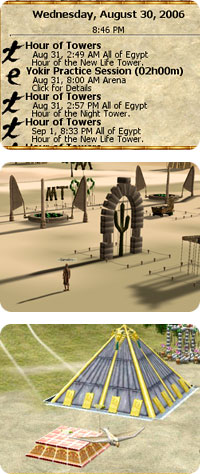By Brad Cook
You’ve heard the story from your great-grandparents: a mysterious Stranger arrived in Egypt and challenged the people to build a world outside the Pharaoh’s decrees. He asked them to pass 49 tests and work together as a nation to build seven Great Monuments.
The first time the Stranger made his demands, the people of Egypt succeeded in building all of the monuments. During a second visit by a new Stranger, however, their grandchildren only completed four of the seven structures before time ran out. Now the great-grandchildren of the original Egyptians strive to exceed their forebears’ achievements after a third Stranger appears.
Leaving a Legacy
As we explained in our article detailing A Tale in the Desert II, this massively multiplayer online role-playing game differs from many of its kin by emphasizing cooperation, building construction, and rule-making, with nary a violent action to be found. Each iteration of the game is known as a Telling, with the third one now in progress.

As before, you tackle seven disciplines — Architecture, Art and Music, Harmony, Human Body, Leadership, Thought, and Worship — with seven tests of increasing difficulty found in each. Those aforementioned monuments correspond to the disciplines, and each one requires 127 Egyptians who have passed at least one test in the required discipline. Those who build each Great Monument also get to design a new test in that discipline, thus leaving a legacy for the next generation.
The 12 Great Monuments (more than one can be constructed for each discipline) built during the past two Tellings still stand in Egypt, serving as inspiration to those who wish to meet the Stranger’s latest challenge. Remember: the Stranger has been known to come up with unexpected demands as the time draws near for Egypt to complete a Telling, so stay alert for last-second changes in your game plan.
Making Your Mark
After passing your initial citizenship test, which is more complex than the tests found in previous Tellings, you begin your life on the Egyptian mainland. As in the previous two iterations of the game, you build your own compound where you store your excess inventory (you can only carry so much slate, wood, and so forth) and work on projects.
Your compound also serves as your mark on the landscape, a notice to other players that you’ve accomplished tasks and passed tests. Customize it with sculptures and other pieces of art to make it unique.
Once you’ve established a home base, you can invite other characters to help you with projects or travel to their compounds and assist with their work. Cooperation is a major part of the game, since Egyptians can’t possibly meet the Strangers’ demands if they don’t play nice. While some characters may achieve great things, and even become Demi-Pharaohs with the ability to ban unruly characters, Egypt as a whole suffers if everyone thinks only of themselves.
And if you’re unhappy with any aspect of the game, simply devise a law to change it. If enough other players vote for it, your law will become the rule of the land.
Mysteries Abound
Each Telling has so far offered odd events that only make sense as time passes and related incidents occur. The third Telling, which started at the end of May, 2006, is no different. With previous Tellings lasting approximately 20 months, you can expect plenty more strange happenings to take place.
So far, people in the Qatara region have, on three consecutive days, noticed a desert wind blowing from a specific direction. Heading that way led to an altar that allowed them to meditate. Each altar also turned out to be a puzzle that provided the password needed to meditate at the next one indicated by the desert wind.
In addition, several players have reported being teleported from their current location to a place with an image of a pyramid on the ground. Then, just as suddenly, they were sent back to the original spot, as if nothing had happened. One of them asked: “What does it all mean? What caused this strange vision? Was I chosen? Or simply plucked at random from the god’s hat?”
Those mysteries, as well as others, will be revealed in due time. And you can bet a handful of flax seeds that they will tie into as-yet-unannounced challenges from the new Stranger. Join the fun to find out more.





